
With continued strong demand for summer pasture, some producers are looking at cropland alternatives to produce grazing forage. This typically involves planting cool- or warm-season forages and in many cases, double-cropping annuals. An important challenge in these systems is getting an extended, continuous period with available forage to be grazed. This can be achieved through using a combination of warm- and cool- season annuals.
Species Selection and Management
There are numerous cool- and warm-season annuals that can be used for forage. Cool- and warm-season species should be planted separately, but mixtures of several cool-season species could be planted, and similarly, mixtures of different warm-season species could be used.
Warm-Season Annual Grasses
Warm- season annual grasses can be planted in late spring or early summer to provide mid and late summer grazing or stockpiled and used for winter grazing. Sudangrass is a rapidly growing warm-season grass, with good regrowth potential. It usually contains lower levels of prussic acid than sorghum-sudangrass hybrids, but it is also slightly lower yielding.
Sorghum-sudangrass hybrids resemble sudangrass, but the hybrids are taller, have larger stems and leaves, and generally produce higher yields. However, it has a slower regrowth rate and is more likely to contain toxic levels of prussic acid. It can also become coarse and unpalatable if allowed to become too mature before grazing.
Pearl millet is another annual grass that could be grown for supplemental forage. It tends to have smaller stems and is leafier than the other grasses and it does not produce prussic acid. However, it has less regrowth potential than other summer annuals.
For more information on selection and management of warm-season (summer) annual grasses, see NebGuide G2183, Summer Annual Forage Grasses.
Cool-Season Annual Grasses
Spring small grain cereal grasses such as oats, spring triticale, spring barley and spring wheat can be planted in early spring to provide late spring and early summer grazing or planted in mid or late summer to provide fall grazing. They will not survive over winter and thus, no spring grazing.
Generally, winter small grain varieties will not produce as much fall growth as spring small grain varieties. Winter small grains can be planted in the fall to provide earlier spring grazing than spring varieties planted in early spring.
Brassicas
Brassicas (turnips, kale, rape, etc.) can be high-yielding and high-quality. Due to their ability to scavenge nitrogen, they tend to have relatively high protein content. It is recommended that they be mixed with small grains for grazing. The most common use is for fall or winter grazing, but they can be planted in the early spring with spring small grains. Most brassicas have a high energy content even when mature. This quality is maintained later into winter than the small grains.
For more information on summer/fall planting of cool season annuals, see NebGuide G2262, Annual Cool-Season Forages for Late-Fall or Early-Spring Double-Crop.
Fertilization
Annual forages must be fertilized to reach their yield potential. However, fertilizer application should be according to soil test recommendations. With warm-season annual grasses, nitrogen is most often the limiting nutrient. Typically, 50 to 60 lb N per acre is needed at establishment. Additional nitrogen may be needed after the first grazing or haying to promote regrowth. Adequate rainfall or irrigation and favorable temperatures are needed with additional N fertilization to reduce nitrate risk. For cool-season annuals 50 to 60 lb N per acre is typically needed.
Irrigation
In central and western Nebraska, irrigation will increase yields and improve the reliability of forage production. More information on irrigation management for forages is in NebGuide G2012, Forage Production with Limited Irrigation.
System Development
All tables link to larger versions.
Table 1. System A: Example of approximate planting and grazing periods of double-cropped annual forages to provide extended grazing.
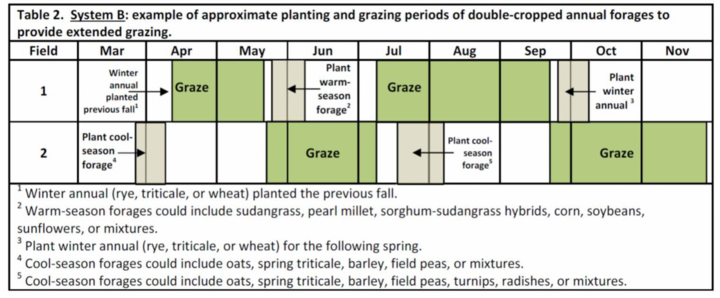
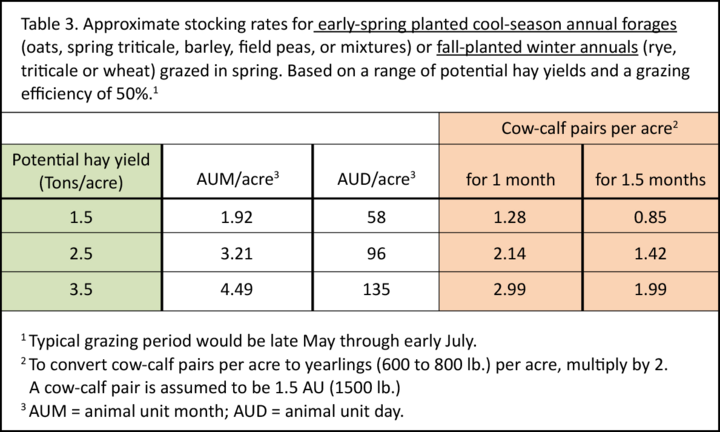
Table 4. Approximate stocking rates for mid- to late-summer planted cool-season annual forages (oats, spring triticale and barley, field peas, turnips, radishes, or mixtures) based on a range of potential hay yields and a grazing efficiency of 50%.
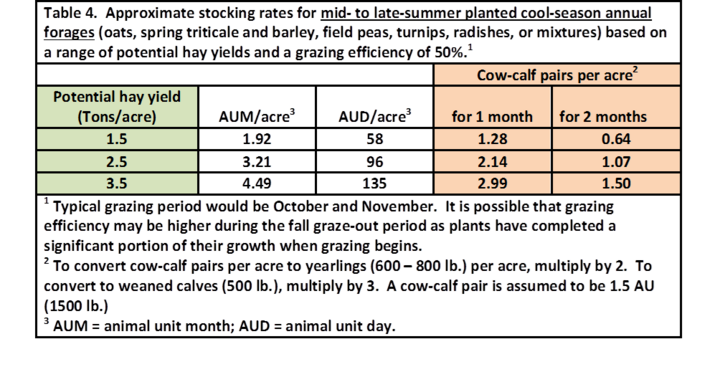
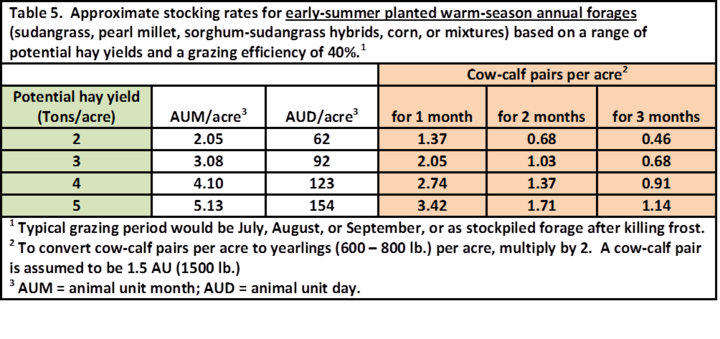
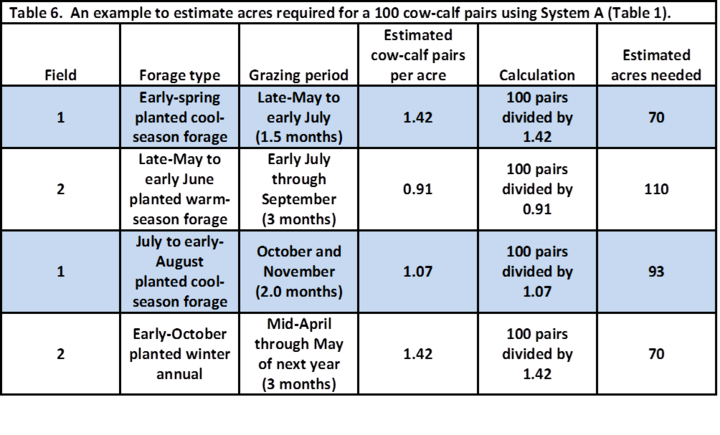
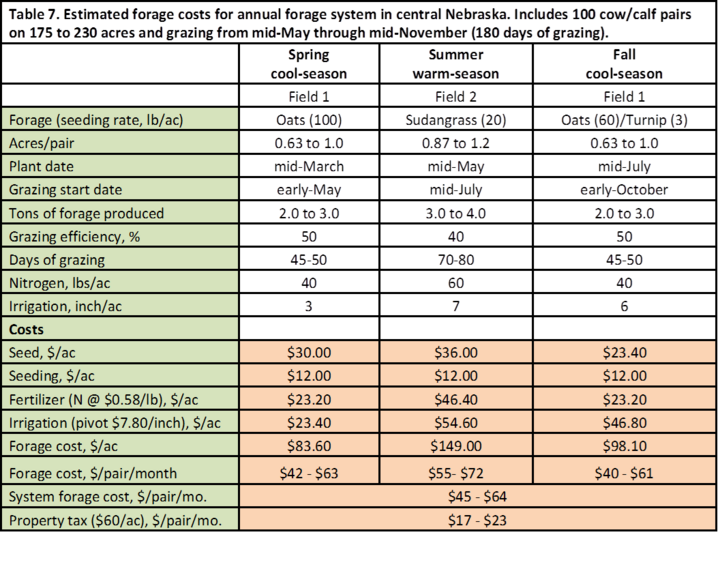
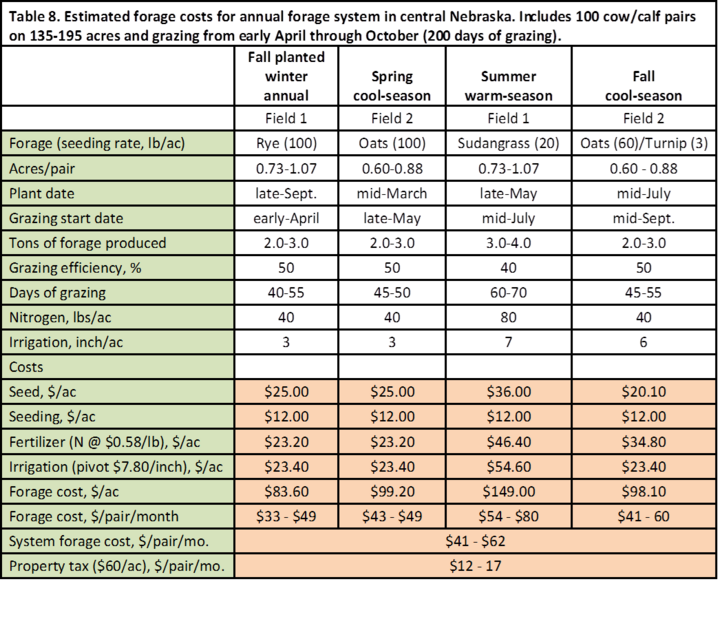
Timing of planting is critical when trying to have an extended, continuous period with forage that can be grazed. Tables 1 and 2 (System A and System B) provide examples of suggested planting times and potential grazing periods for annual forages using multiple fields in the system. On these calendar tables, possible planting time windows are identified (tan shaded) that would result in the potential grazing periods (green shaded). Adequate moisture and other weather conditions are assumed.
System A can be used for starting an annual forage system in the spring and could be transitioned to System B with planting a winter annual in the fall when grazing of the warm-season forage was complete.
With any of these plans, it is necessary to have access to additional forage resources such as hay and an area to drylot feed or a nearby permanent pasture where cattle could be moved if any number of circumstances caused a shortage in the amount of forage needed to continue grazing the planted fields. Similarly, for each of the forage types, additional acres could be planted as a reserve for forage shortages and harvested for hay if not needed for grazing.
For each of the example systems, corn residue could grazed during the winter if available. If corn residue was not available or used, Table 1 includes an optional third field that could be planted to a small grain cereal in the spring, then harvested for hay or grazed until late June. A warm-season annual would then be planted and grazed as winter stockpile. An alternative to using this as winter stockpile is to windrow it in September and directly graze the windrows during winter. More information on this management practice can be found in NebGuide G1616, Windrow Grazing.
Grazing Efficiency and Grazing Management
Another key factor associated with annual forages is grazing efficiency, which refers to the percent of forage actually consumed by the grazing animal. With grazing, factors such as stage of growth when grazing starts, grazing or rotation strategy, palatability of the forage, and trampling losses all affect grazing efficiency. In addition, grazing interrupts plant growth which could affect potential forage production. In general, grazing efficiency is lower for the taller-growing warm-season annual forages than for cool-season species, especially if grazing occurs when they are relatively mature.
The targeted height to begin grazing depends on the species. For small grains, grazing can begin when they are 6 to 8 inches tall. With sudangrass, grazing can begin at about 18 inches in height. Since sorghum-sudangrass hybrids usually contain prussic acid, grazing should not begin until plants are at least 20 to 24 inches tall. Pearl millet can be grazed when it is 12 to 15 inches tall.
It is a good idea to divide fields into three or more smaller paddocks of a size that permits animals to graze a paddock to the targeted end height within 7 to 10 days. For most warm-season grasses the target residual height to allow good regrowth is 8 inches. For most cool-season small grains, the target residual height is about 4 inches. More information on grazing management of warm-season (summer) annual grasses can be found in NebGuide G2183, Summer Annual Forage Grasses.
Carrying Capacity and Stocking Rates
Another crucial part of planning an annual forage system is estimating what the livestock carrying capacity will be. This in turn, will help determine the number of acres of each of the forage types that need to be planted. Production of different annual forages will vary with several factors such as species, growing conditions, planting date, irrigation, and fertilizer management. Spring-planted small grain cereals or winter annuals commonly yield about 2 to 3 tons/acre. Warm-season annuals typically produce 3 to 5 or more tons/acre. Production from mid- to late-summer planted small grain cereal monocultures or mixtures with brassicas can range from 1 to 3 tons/acre with the higher yields related to earlier planting.
Potential hay yield and stocking rate estimates provide starting points for estimating carrying capacity for cool- and warm-season annual forage systems (Tables 3, 4, and 5). Using a planned grazing rotation with several paddocks, a grazing efficiency of 40% for warm- and 50% for cool- season annual grasses can be attained. Grazing efficiency may be higher in fall if plants have completed a significant portion of their growth when grazing begins.
To estimate the number of acres needed of each of the forage types for a planned system, divide the total number of head by the carrying capacity estimates. Table 6 provides an example of these calculations following the plan illustrated in Table 1 (System A).
Potential Forage-Related Cattle Disorders
Prussic-acid poisoning can occur with sudangrass and sorghum-sudangrass hybrids. However, certain varieties of sudangrass or sorghum-sudangrass hybrids are known to be lower in prussic acid potential than others. Therefore, it is best to select varieties that are known to have low potential for the production of prussic acid and not begin grazing until plants have reached the target height of 18 to 24 inches. When grazing in late fall, take care to remove cattle from prussic acid-producing species before frost. Grazing can resume 10 days after a hard-killing frost. For more information see NebGuide G2184, Cyanide Poisoning.
Nitrate poisoning can be an issue with all annual grasses as well as with brassicas and usually occurs when high rates of nitrogen fertilizer are used in one application or when factors such as detrimental weather interfere with plant growth. For more information, see NebGuide G1779, Nitrates in Livestock Feeding.
When grazing small grains in the spring or fall, grass tetany is a concern for lactating cows. Feeding a free-choice mineral that has 12-15% percent magnesium with a target intake of 3 to 4 ounces per day will reduce the incidence of grass tetany.
Despite the potential for forage toxicity, both summer and winter annual forages offer opportunities for economical forage production.
Cost of Forage Production
Table 7 provides an example of a system following the plan illustrated in System A (Table 1) with an estimate of costs for producing the forage. Table 8 provides an example of a system following the plan illustrated in System B (Table 2). The system in Table 7 requires more land per pair but has less input costs compared to the system in Table 8.
Current pasture rental prices in the center part of Nebraska average $62/pair/month and range from $48 to $83/pair/month. Current pasture rental rates are at high enough levels to suggest there may be an opportunity to use annual forage systems economically. However, this will vary significantly across regions and operations. Producers need to take a serious look at their own situation before incorporating this sort of change into their operation.
Jerry Volesky, Range and Forage Specialist
Mary Drewnoski, Beef Systems Specialist
